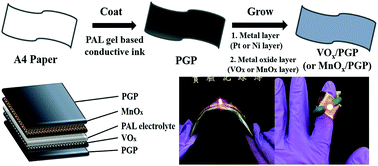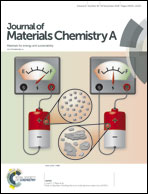4.2 V wearable asymmetric supercapacitor devices based on a VOx//MnOx paper electrode and an eco-friendly deep eutectic solvent-based gel electrolyte†
Abstract
In this work, we successfully fabricated 3D network vanadium oxide (VOx) and manganese oxide (MnOx) nanofibers on conductive paper (PVA–acetamide–LiClO4-graphite/paper, PGP) as electrodes linked with an eco-friendly PVA–acetamide–LiClO4 (PAL) deep eutectic solvent-based gel electrolyte for high-voltage wearable asymmetric supercapacitors (HVWASCs). An ecologically compatible deep eutectic solvent-based electrolyte with self-supporting electroactive species has been generally accepted as a unique type of cost-effective and green electrolyte that possibly involves a bulk concentration of the electroactive species and a large working potential window, thereby achieving a high performance. The HVWASCs are able to work with a large operating voltage of 4.2 V, and supply outstanding energy and power densities (245 W hkg−1 at 0.18 W kg−1 and 95.3 kW kg−1 at 98 W h kg−1). The HVWASCs demonstrate remarkable cycling stability and durability after 6000 cycles, including bending and twisting (capacitance retention of 91.5%). The HVWASCs are a superior prospective candidate for wearable/flexible electronic devices and Internet of Things (IoT) applications.



 Please wait while we load your content...
Please wait while we load your content...